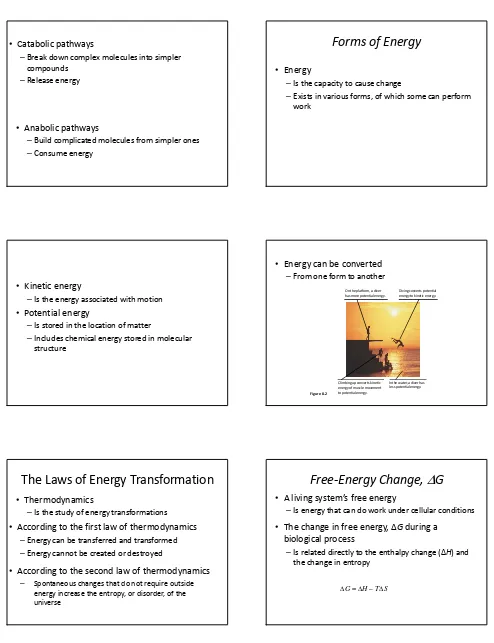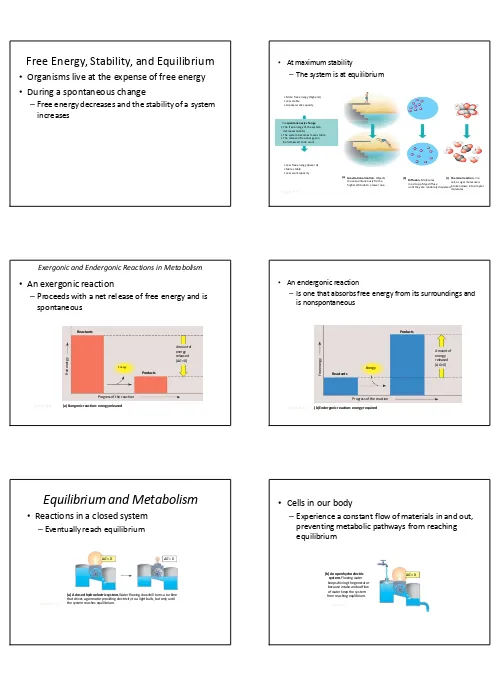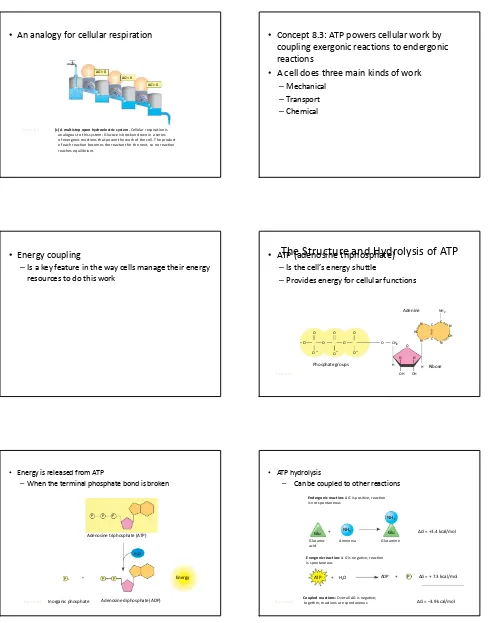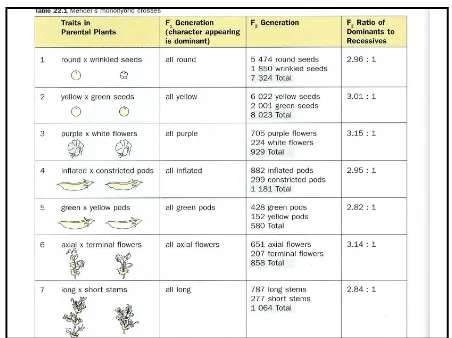HAND OUT
BASIC BIOLOGY 1
By Asri Widowati,
M.Pd.
2010
LEVELS OF COMPLEXITY
• Composed of 4 OR MANY
nucleotide bases, 5 carbon sugar and phosphate.
• Base pair = rungs of a ladder.
• Edges = sugar-phosphate
backbone.
• Double Helix
• Anti-Parallel
Figure 2.
21
CONNECTIVE TISSUE
CONNECTIVE TISSUE CONTINUES
MUSCLE TISSUE
NERVOUS TISSUE
•
•
Stomata
Stomata berdasarkan letaknya ada 2 :
•
Faneropor ( menonjol )
•
Kriptopor ( tenggelam )
METABOLISM
•
Overview: The Energy of Life
•
The living cell
–Is a miniature factory where thousands of reactions occur
–Converts energy in many ways
•
Some organisms
–Convert energy to light, as in bioluminescence
•
Concept : An organism’s metabolism transforms
matter and energy, subject to the laws of
thermodynamics
20
All organisms have
three fundamental
requirements
Carbon
Energy
Mineral nutrients
•
Metabolism
–Is the totality of an organism’s chemical reactions
–Arises from interactions between molecules
Metabolism
• Total of all chemical changes that occur in body. Includes:
–Anabolism: energy-requiring process where small molecules joined to form larger molecules
•E.g. Glucose + Glucose
–Catabolism: energy-releasing process where large molecules broken down to smaller
• Energy in carbohydrates, lipids, proteins is used to produce ATP through oxidation-reduction reactions
Metabolic Pathways
• The enzymatic reactions of metabolism form a network of interconnected chemical reactions, or pathways.
• The molecules of the pathway are called intermediates because the products of one reaction become the substrates of the next.
• Enzymes control the flow of energy through a pathway.
Intermediary Metabolism
Organization of the Chemistry of Life
into Metabolic Pathways
•
A metabolic pathway has many steps
–That begin with a specific molecule and end with a product
–That are each catalyzed by a specific enzyme
Enzyme 1 Enzyme 2 Enzyme 3
A B C D
Reaction 1 Reaction 2 Reaction 3 Starting
molecule
•
Catabolic pathways
–Break down complex molecules into simpler compounds
–Release energy
•
Anabolic pathways
–Build complicated molecules from simpler ones
–Consume energy
Forms of Energy
•
Energy
–Is the capacity to cause change
–Exists in various forms, of which some can perform work
•
Kinetic energy
–Is the energy associated with motion
•
Potential energy
–Is stored in the location of matter
–Includes chemical energy stored in molecular structure
•
Energy can be converted
–From one form to another
On the platform, a diver has more potential energy.
Diving converts potential energy to kinetic energy.
Climbing up converts kinetic energy of muscle movement to potential energy.
In the water, a diver has less potential energy.
Figure 8.2
The Laws of Energy Transformation
•
Thermodynamics
–Is the study of energy transformations
•
According to the first law of thermodynamics
–Energy can be transferred and transformed
–Energy cannot be created or destroyed
•
According to the second law of thermodynamics
– Spontaneous changes that do not require outside energy increase the entropy, or disorder, of the universe
Free-Energy Change,
∆
G
•
A living system’s free energy
–Is energy that can do work under cellular conditions
•
The change in free energy, ∆
G
during a
biological process
–Is related directly to the enthalpy change (∆H) and the change in entropy
Free Energy, Stability, and Equilibrium
•
Organisms live at the expense of free energy
•
During a spontaneous change
–Free energy decreases and the stability of a system increases
• At maximum stability
–The system is at equilibrium
Chemical reaction.In a cell, a sugar molecule is broken down into simpler molecules.
.
Diffusion.Molecules in a drop of dye diffuse until they are randomly dispersed.
Gravitational motion.Objects move spontaneously from a higher altitude to a lower one. • More free energy (higher G)
• Less stable • Greater work capacity
• Less free energy (lower G) • More stable • Less work capacity In aspontaneously change
• The free energy of the system decreases (∆G<0) • The system becomes more stable • The released free energy can
be harnessed to do work
(a) (b) (c)
Figure 8.5
Exergonic and Endergonic Reactions in Metabolism
•
An exergonic reaction
–Proceeds with a net release of free energy and is spontaneous
Figure 8.6
Reactants
Products Energy
Progress of the reaction
Amount of energy released (∆G<0)
F re e e n e rg y
(a) Exergonic reaction: energy released
• An endergonic reaction
–Is one that absorbs free energy from its surroundings and is nonspontaneous Figure 8.6 Energy Products Amount of energy released (∆G>0) Reactants
Progress of the reaction
F re e e n e rg y
(b) Endergonic reaction: energy required
Equilibrium and Metabolism
•
Reactions in a closed system
–Eventually reach equilibrium
Figure 8.7 A
(a) A closed hydroelectric system.Water flowing downhill turns a turbine that drives a generator providing electricity to a light bulb, but only until the system reaches equilibrium.
∆G< 0 ∆G= 0
•
Cells in our body
–Experience a constant flow of materials in and out, preventing metabolic pathways from reaching equilibrium
Figure 8.7
(b) An open hydroelectric system.Flowing water keeps driving the generator because intake and outflow of water keep the system from reaching equlibrium.
•
An analogy for cellular respiration
Figure 8.7 (c) A multistep open hydroelectric system.Cellular respiration is
analogous to this system: Glucoce is brocken down in a series of exergonic reactions that power the work of the cell. The product of each reaction becomes the reactant for the next, so no reaction reaches equilibrium.
∆G< 0 ∆G< 0
∆G< 0
•
Concept 8.3: ATP powers cellular work by
coupling exergonic reactions to endergonic
reactions
•
A cell does three main kinds of work
–Mechanical
–Transport
–Chemical
•
Energy coupling
–Is a key feature in the way cells manage their energy resources to do this work
The Structure and Hydrolysis of ATP
•
ATP (adenosine triphosphate)
–Is the cell’s energy shuttle
–Provides energy for cellular functions
Figure 8.8
O O O O CH2
H OH OH H N H H O N C HC
N C C N NH2 Adenine Ribose Phosphate groups O O O O O O -- - -CH
• Energy is released from ATP
–When the terminal phosphate bond is broken
Figure 8.9
P
Adenosine triphosphate (ATP)
H2O
+ Energy
Inorganic phosphate Adenosine diphosphate (ADP)
P P
P P P i
• ATP hydrolysis
– Can be coupled to other reactions
Endergonic reaction:∆Gis positive, reaction is not spontaneous
∆G= +3.4 kcal/mol Glu Glu
∆G= + 7.3 kcal/mol ATP + H2O
+ NH3
ADP + NH2
Glutamic acid
Ammonia Glutamine
Exergonic reaction:∆ Gis negative, reaction is spontaneous
P
Coupled reactions:Overall ∆G is negative;
together, reactions are spontaneous ∆G= –3.9 kcal/mol
How ATP Performs Work
•
ATP drives endergonic reactions
–By phosphorylation, transferring a phosphate to other molecules
• The three types of cellular work
–Are powered by the hydrolysis of ATP
(c) Chemical work: ATP phosphorylates key reactants
P
Membrane protein
Motor protein
P i
Protein moved
(a) Mechanical work: ATP phosphorylates motor proteins
ATP
(b) Transport work: ATP phosphorylates transport proteins
Solute
P P i transported Solute Glu Glu NH3 NH2
P i
P i
+ +
Reactants: Glutamic acid and ammonia Product (glutamine) made ADP + P Figure 8.11
The Regeneration of ATP
•
Catabolic pathways
–Drive the regeneration of ATP from ADP and phosphate
ATP synthesis from ADP + P irequires energy
ATP
ADP + P i
Energy for cellular work (endergonic, energy-consuming processes) Energy from catabolism
(exergonic, energy yielding processes)
ATP hydrolysis to ADP + P iyields energy
Figure 8.12
•
The activation energy, E
A–Is the initial amount of energy needed to start a chemical reaction
–Is often supplied in the form of heat from the surroundings in a system
• The energy profile for an exergonic reaction
F re e e n e rg y
Progress of the reaction
∆G < O EA A B C D Reactants A C D B Transition state A B C D Products
How Enzymes Lower the E
ABarrier
•
An enzyme catalyzes reactions
•
The effect of enzymes on reaction rate
Progress of the reaction Products
Course of reaction without enzyme
Reactants
Course of reaction with enzyme
EA without enzyme
EA with enzyme is lower
∆Gis unaffected by enzyme
F
re
e
e
n
e
rg
y
Figure 8.15
Substrate Specificity of Enzymes
•
The substrate
–Is the reactant an enzyme acts on
•
The enzyme
–Binds to its substrate, forming an enzyme-substrate complex
GENETICS
• How do offspring come to resemble their parents physically?
• Genetics begins with the unifying assumption that biological inheritance is carried by structures called Genes.
• The same basic patterns of inheritance apply to most organisms.
• The inheritance of somehuman traits can be explained from work on plants
• Sex-linked traits in humans is more complicated
•
– Was the first person to analyze patterns of inheritance
– Deduced the fundamental principles of genetics
•
Phenotype
– An organism’s physical traits
•
Genotype
•
Allele
: Alternate form of a gene at same position
on pair of chromosomes that affect the same trait.
•
Dominant Allele: Capital Letter--O
•
Recessive Allele: lowercase letter--o
•
Homozygous Dominant-
-OO
•
Homozygous Recessive-
-oo
•
Heterozygous
--Oo
– These plant are easily
manipulated – These plants can
self-fertilize
Stamen
Carpel
Mendel’s Peas
Garden pea
Dominant Recessive
White
Pod shape Inflated Constricted
Flower position
Pod Color
Dominant Recessive
Flower color Purple
Axial Terminal
Green Yellow
Tall Dwarf
Seed shape Round Wrinkled Seed color Yellow Green
Stem length
Monohybrid Inheritance
•
Mendel selected several varieties of garden
peas that has different characteristics. E.g :
–Short and tall plants
–Red or white flower plants
–Seeds that were either yellow or green, or round and wrinkled
•
Inheritance involving only
one pair of
contrasting characters
is called
monohybrid
inheritance
P Generation (true-breeding parents)
All plants have purple flowers
Fertilization among F1 plants
(F1 ××××F1)
F2Generation
3/ 4of plants
have purple flowers
1/ 4of plants
have white flowers Purple
flowers Whiteflowers
F1Generation
F2 = 3:1 ratio
Some terms…
Hybrid
A hybrid is the offspring from two different varieties or species
F1generation
Also known as first filial generation
F2generation
• Using a Punnett square to explain the results of a monohybrid cross
Figure 9.8b P plants
Gametes
PP
p
F1plants:
(hybrids)
Gametes
AllPp
1/ 2
PP
All P All
P 1/
2
P
p
PP
Pp Pp
F2plants:
Eggs Sperm
p P
Phenotypic ratio 3 purple : 1 white
Genotypic ratio 1 PP: 2 Pp: 1 pp
p
pp
Question
•
Why does the observed ratios differ from
expected ratios, especially when there are
small numbers of progeny?
Results of all experiments
•
One trait or character remained unchanged in
the F
1hybrids while the other trait seemed to
disappear
•
This character then appear again in the F
2generation but only in about one-quarter of
the total number of offsprings
•
Trait unchanged –
dominant trait
•
Trait disappeared and appear again –
recessive
trait
Mendel’s suggestion
• Hereditary factors are responsible for the transmission of characteristics
• Each characteristic controlled by a pair of factors in the cells of an organism
• The two factors in each pair separate (segregate) during gamete formation and each gamete contain only one factor Mendel’s Law of Segregation
• Fusion of gamete restores the diploid conditionin the zygote
• from the monohybrid crosses, Mendel derived 4 hypotheses….combined, we now refer to these as…
– There are alternative forms of genes, now called alleles
– For each characteristic, each organism has two genes
– Gametes carry only one allele for each inherited characteristic
– Alleles can be dominant or recessive
= Mendel’s Principle of Segregation • What happens when you follow the
inheritance of morethan a single trait at one time?
• How do two different traits get passed to offspring?
A Dihybrid Cross
RRYY rryy
GametesRY ry
RrYy
ry Ry
rY RY RY
Eggs Sperm
rY
Ry ry
RRYY RrYY RrYY RRYy rrYY RRYy RrYy RrYy RrYy RrYy
rrYy RRyy rrYy Rryy Rryy
rryy
9/ 16
Yellow round
3/ 16
Green round
3/16
Yellow wrinkled
1/16 Green
wrinkled
Dihybrid Cross
RrYy RrYy
9:3:3:1
•
Mendel’s principle of independent assortment
– Each pair of alleles segregates independently of the other pairs during gamete formation
P a b
Genotype:
P a B
PP aa Bb
• A testcross is a mating between:
– An individual of unknown genotype and – A homozygous






